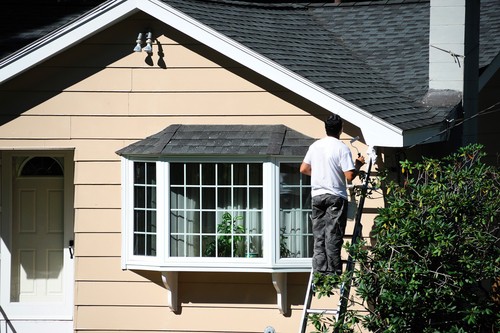With fall bringing cooler and drier weather, it makes for the perfect time of year to give the exterior of your home a fresh coat of paint. But even with the right environment, painting a home’s exterior can be a time-consuming task. Adding to the degree of difficulty, there are also a lot of things that may go wrong during the process.
7 Exterior House Painting Tips
If your home could use a touch-up and you’re planning on giving it a fresh coat of paint this fall, then here are seven outside home-painting tips you’ll want to use to help make the job go smoother.
#1: Start With a Clean Canvas
Over the summer, the exterior of your home can accumulate a lot of dirt. In some cases, depending on the amount of wet weather in your area, your home might even have moss or mold growing on it. So, before you can paint the exterior, you first need to clean it. Use a mix of water and a phosphate-free cleanser and a commercial mildew killer concentrate. Or, hire a professional to power-wash your siding, so you’re left with a nice clean surface for applying fresh paint.
#2: Scrape Away Any Loose Paint
If your siding has areas of loose or chipping paint, you will want to use a scraper to scrape it all the way off. Painting over loose paint will only cause the new paint to start peeling quicker than it normally would, so get it out of the way before you begin.
#3: Sand Rough Spots
For smoothing out rough spots on your siding, you’ll want to use a pad sander with 80-grit sandpaper. If you’re using an orbital sander, just be careful you don’t too hard on the sander or you’ll leave marks in the siding, especially if it’s wood siding.
#4: Fill and Repair Holes
Your next step is to inspect your siding to see if any holes, dings or chips are visible. If you find some, fill the holes using a patching putty or compound. Let it dry and sand it until the surface is smooth and even.
#5: Apply a Coat of Primer
Once the siding is prepared, you will want to apply a coat of primer immediately. Don’t wait or the siding could get dirty again. If you’re painting over bare wood or siding that was previously painted with latex paint, then latex primer is fine. But if you’re painting over siding that has had multiple coats of oil-based paint, then you will want to apply a new coat of oil-based primer.
#6: Caulk All Joints
Apply fresh caulk to all joints to help prevent air leaks and block water penetration. For the best results, use polyurethane caulk as it typically carries a 55-year warranty, and will usually hold up better than caulk made from other materials.
#7: Apply the Right Paint for the Job
For outside home painting, water-based acrylic latex is recommended over oil-based paints because it applies easily and dries quickly. It also cleans up with soap and water. But if the exterior was previously painted with oil-based paint, then you’ll have to use oil paint for the new coat, as well.
When painting a home’s siding, less is more. Avoid applying too many layers as this can result in paint flaking off over time. Remember – less paint bonds better to the layer underneath.
Need New Siding? Contact Thompson Creek Today
If your siding can’t be saved with a fresh coat of paint, then it may be time to have new siding installed. At Thompson Creek, we offer a variety of siding options and products that can dramatically improve the beauty, energy efficiency and functionality of your home. With the fall season here, now is the ideal time to schedule your siding installation. To learn more or to find out how we can help improve your home, contact Thompson Creek and get a free estimate for your custom siding installation today.


